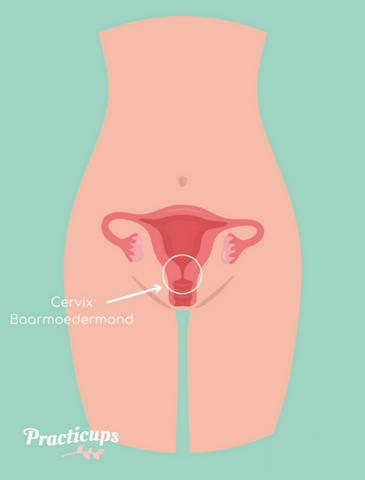In recent years, sustainable menstrual products have become a lot more popular. This also means that there is more supply. A positive development because there is something for everyone. It only makes choosing the perfect product more difficult for you! In addition to menstrual underwear and washable sanitary towels, the menstrual cup is a sustainable option and a good replacement for tampons. But, which cup is right for you?
Before you put the different cups next to each other, it is useful to know how high your cervix is.
-
How high is your cervix?
It is best to measure the height of your cervix during your period. Then it is the lowest. The easiest way to do this is with your middle finger. Your cervix feels like a medium-hard piece of tissue or bulge.
If you can already feel your cervix after 1/3 of your finger, your cervix is low, at 2/3 of your finger your cervix is at average height and everything above that indicates that your cervix is high.
Depending on this, you choose a shape that fits. For example, if you have a low cervix, it is better to opt for a 'shorter' cup (shaped like an egg cup) and if you have a medium to high uterus, you can go for a cup with a longer shape.
If you want more precision, you can hold a tape measure next to the finger you used to measure and compare these millimeters with the size of the menstrual cups.
(Practicups are suitable for a medium to high cervix and have a length of 55-57mm depending on the Practicup size)
-
Form: menstrual cups come in different shapes. When purchasing, make sure that the shape of the cup matches the height of your cervix. Second, you can take into account how heavy your period is.
You can cut off the stem of most cups, do not include this piece when measuring. Only cut the stem if you feel confident inserting and removing your menstrual cup.
The stem is not made to remove a menstrual cup. Only to put the cup in a better position.
-
Material: usually menstrual cups are made of medical silicone, but there are also cups made of rubber and TPE. When purchasing a cup, take any allergies into account. Tip: medical grade silicone is anti-allergenic and therefore suitable for everyone.
-
Steal: a stalk often gives a sense of security. Most stems are just not made to actually remove a menstrual cup. Not only is it not good for your body to have one remove menstrual cup by pulling the stem, the stem will break off in many cups even after short-term use. The stem on menstrual cups is made to position the cup differently. For example, to create a good vacuum or to get to the bottom of the cup better so that you can remove the cup properly.
Always make sure to break the vacuum before using one menstrual cup removed.
If you don't feel the stem while wearing your menstrual cup, you can just leave it in place. If you can feel the stem, you can cut it off at Practicups. Only cut the stem if you are experienced enough in inserting and removing your cup.
-
Rand: there are cups with thick rims, thin rims or no rim at all. A cup with a rim is less likely to sink down. A thick brim, on the other hand, can be somewhat uncomfortable.
-
Mate: It is often thought that the size of a menstrual cup depends on the intensity of your period. This is true, but the size is especially important for wearing comfort. If you have a fine build and are a virgin, choose a smaller cup size. If you gave birth vaginally and you have a heavy menstrual period, a larger cup size is probably better. This is not a golden rule, but more of a guideline. You know your own body best!
-
Length: the length of the cup is especially important if you have a low or high cervix. So keep this in mind. At the beginning of this article, we explain how to measure the height of your cervix.
-
Colour: do you go for natural (ie a transparent cup) or do you prefer a tan? Keep in mind that colored menstrual cups often contain more ingredients. A transparent cup is usually the most environmentally friendly. One reason why you would choose a colored cup is, for example, so that you see discoloration less quickly. A disadvantage of colored cups is that this makes you less able to monitor your period and the texture of your blood loss.
-
Hardness: the ideal hardness of your cup has to do with your pelvic floor muscles. Soft cups are suitable for most women, while hard cups can often only be used by women with very high muscle tone in the pelvic floor muscles. If you have a sensitive bladder and/or vagina, choose a soft cup.
- Finish: matte cups often have a silky smooth finish, while more transparent cups are a bit stickier. This is a matter of personal preference.


